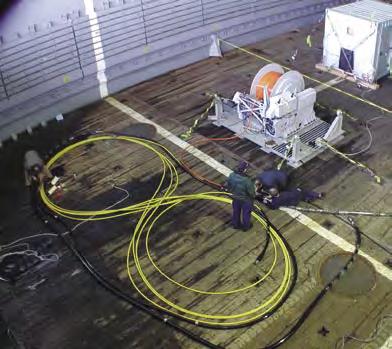
7 minute read
Anti-Torpedo Defense


Advertisement

Anti-Torpedo Defense: Anti-Torpedo Defense: Defeating a Ubiquitous Defeating a Ubiquitous Threat to Naval Superiority Threat to Naval Superiority

At the height of the Cold War in the mid-1980s – as a modern, quieter, and expanded Soviet submarine force seemed ready to challenge the U.S. Navy, anytime, anywhere – concerns spiked when intelligence indicated that the Soviets had developed a new type of long-range torpedo that homed on the wake of surface ships. Existing countermeasures were of no value, and Navy science and technology mavens struggled to find an answer. The “wake-homer” torpedo threat was so severe that then-Deputy Chief of Naval Operations, Surface Warfare (OP-03), Vice Adm. Joseph Metcalf declared the only counter to it was to “...position a frigate astern of every high-value unit.” The response of the frigate community to Metcalf’s “solution” was quick and vocal.




The Counter-Torpedo Detection Classification/ Localization (DCL) system is shown here aboard USS Cleveland (LPD-7). The system is made up of (r to l) the winch, DCL in-board processor, and power generator. The entire system can be easily loaded and offloaded.

USS Cleveland (LPD-7), seen here, was used as a test platform for the counter-torpedo detection/ classification/localization operations.
While hyperbole, perhaps, Metcalf’s remark underscored the Navy’s still-growing concern about the torpedo. For example, information on the 50-knot Soviet Type 65 wake-homing torpedo, what naval strategist Norman Polmar, writing in the December 1989 U.S. Naval Institute Proceedings, called the “largest and most lethal non-nuclear torpedo in existence,” greatly stimulated research in the United States and other allied navies on ways to defeat these weapons. Later news that the Soviets had developed a rocket-propelled, hyper-velocity (200-knot-plus) Shkval torpedo further accelerated the search for effective countermeasures. The danger from even “obsolete” World War II-era torpedoes was dramatically illustrated when the Royal Navy submarine HMS Conqueror fired two MK 8 torpedoes, sinking the Argentine cruiser ARA General Belgrano during the 1982 Falkands war – the first time torpedoes had been fired in anger against a warship since 1945. (During the Korean War, according to Polmar, air-launched U.S. Navy MK 13 torpedoes were used effectively against a dam in North Korea.)
Although the Soviet Navy imploded following the fall of the Berlin Wall, Russian submarines, sensors, and weapons are commercially available, and they compete for market share with the platforms and anti-ship/submarine torpedo systems of other countries. Iran, for example, operates three Russian-built Kilo submarines and makes no apologies for attempting to acquire Shkvals and advanced wakehomers. “The submarine threat to our strategies and operations is real, and it is growing” the Navy’s unclassified ASW publication Changing the Calculus: Guide to U.S. Navy Anti-Submarine Warfare... Threats, Concepts, and Programs 2005, concludes. “High speed, wake-homing, and other torpedoes are now available for open purchase,” it continues, and “... several navies have taken advantage of the availability of Russian high-performance wake-homing torpedoes that can be fired at long range with a significant probability of kill.”
These assessments continue to spur developments on anti-torpedo systems that are just now beginning to bear fruit, and look to provide practical – not hyperbolic – solutions to defending U.S. submarines and surface ships from the nearly ubiquitous threat of torpedo attack.
Past is Prologue
At a classified Undersea Warfare Conference in Washington, mid-August 1948, representatives from the office of the Assistant Chief of Naval Operations (Undersea Warfare) and the National Research Council assessed a burgeoning Soviet submarine force that had begun to incorporate advanced German technologies and systems. The Battle of the Atlantic was still fresh in their minds: “For success we must achieve two things,” they concluded, “first we must vitiate the effectiveness of the submarine torpedo, or develop an equally effective counter-weapon.
“Second, we must remove the detection advantage presently enjoyed by the submarine force over the surface ship.”
In the following years, several efforts – including “Project GENERAL Type 2-A,” a hard-kill anti-torpedo device streamed behind surface ships, which was the focus of the discussions in August 1948 – were undertaken to address the torpedo threat. The U.S. Navy’s T-MK 6 Fanfare soft-kill system, which was based on WWII “foxer” devices to defeat German acoustic homing torpedoes, showed some promise, and in 1985 the Navy deployed the AN/SLQ25 “Nixie” towed decoy. These and other hard- and soft-kill systems – for example, electromagnetically-launched kinetic-kill projectiles to intercept incoming torpedoes, submarine-generated shock waves to disrupt torpedo guidance systems, and a variety of ship- and submarine-launched expendable acoustic decoys and jammers – provided only limited improvements in countering the more advanced and sophisticated torpedoes coming into Soviet and other navies’ inventories.
Two decades later, in mid-2006, the Navy is pursuing several programs intended to “vitiate the effectiveness” of the torpedo, whether launched from a submarine, surface ship, or aircraft, and accomplish the first goal of the 1948 Undersea Warfare Conference, even if the second goal – removing the detection advantage of the submarine over the surface ship – seems as elusive as ever.
Current Efforts
The 2006 edition of the CNO’s annual program guide, Sea Power for a New Era, outlines key programs intended to enhance U.S. torpedo countermeasures effectiveness. For one, improvements to the AN/ SQQ-89A(V)15 USW Combat System on surface warships include a multifunction towed array with acoustic intercept sensor and the Torpedo Recognition and Alertment Functional Segment (TRAFS) to provide warning that a torpedo is inbound.
The Navy and Penn State University’s Applied Research Laboratory are also developing an Anti-Torpedo Torpedo (ATT) that could be launched from both submarines and surface ships to intercept and destroy inbound threats. (Other key ATT players include the Naval Undersea Warfare Center, Newport, R.I., and the Naval Surface Warfare Centers in Indian Head, Md., and Crane, Ind.) As currently configured, the 200-pound ATT is 6.75 inches in diameter, 105 inches long, and powered by a stored chemical-energy propulsion system similar to the Navy’s MK 50 torpedo. Advances in electronics miniaturization, significant increases in microprocessor computation rates, and sophisticated processing algorithms have overcome the shortcomings of the previous ATT program, which was cancelled in 1994. A capability to launch multiple ATTs simultaneously to defeat multiple, salvo-fired torpedoes is a required feature. Tests of the ATT have been planned for late 2006.
Knowledge that a threat is imminent – and a kill mechanism to defeat that threat – are necessary, but clearly are not sufficient to solve the torpedo problem. For this reason, the Naval Sea Systems Command, the Program Executive Office (PEO) for Submarines, and the Office of Naval Research (ONR) have teamed on the AN/WSQ-11 Surface Ship Torpedo Defense System (TDS), which will have some application to submarines as well as to surface platforms. One aspect of ONR’s ATT project in the fleet/Force Protection Future Naval Capability program, the WSQ-11 will provide a major upgrade to current TDS capabilities in automated torpedo detection, classification, and localization sub-systems that will deliver enhanced early alertment as well as firecontrol quality data for the ATT.
The Counter-Torpedo Detection/
Classification/Localization (DCL) system will provide a technical design package and advanced design models for a high-frequency array. It will also provide torpedo detection and tracking algorithms for salvo engagements of up to four threat torpedoes simultaneously. The initial focus is to equip ASW units (e.g., destroyers and cruisers), although future variants could be incorporated into ASW high value unit platforms (aircraft carriers, amphibious assault ships, etc.). The primary elements of the WSQ-11 are: > Tripwire DCL, which includes, (1) a Flexible Towed Source (FTS) that retains SLQ-25A Nixie Acoustic Decoy Function for softkill, but adds an active acoustic source for torpedo detection, advanced processing to deal with a quiet threat, and false-alarm reduction enhancements; (2) an Acoustic Intercept Receiver that detects active acoustic signals from threat torpedoes and radiated noise from torpedo propulsion, and a receiver for FTS active returns; and (3) a Command and Control Processor, to conduct active/passive search and provide an automated threat-level response > The hard-kill Anti-Torpedo Torpedo for all threats, a self-contained launcher, and a canisterized launch system
continued on page 36
The tri-band array is seen here partially unspooled in Cleveland’s welldeck.

This graphic shows an aircraft carrier towing a tri-band array as well as the type of torpedoes it is designed to detect. U.S. Navy photo










